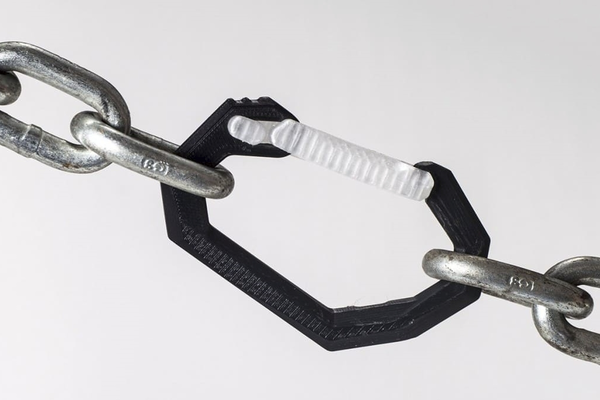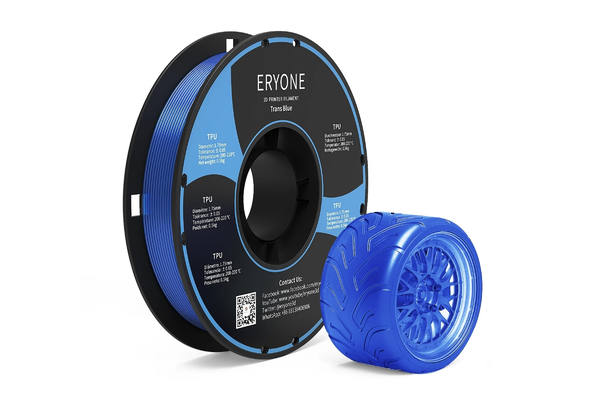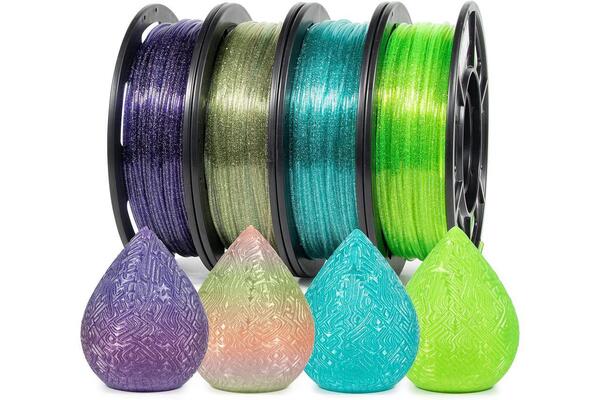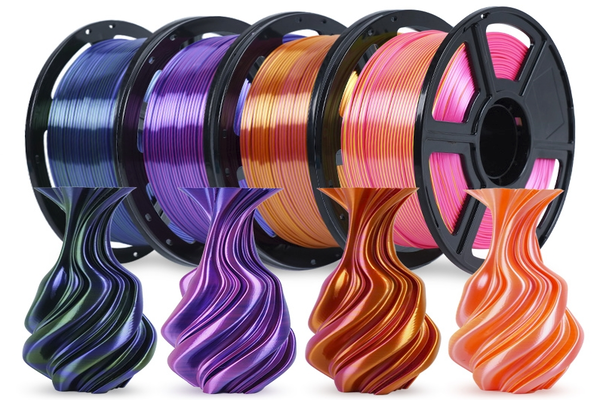The choice of filament is crucial as it determines the mechanical properties, finish, and durability of the printed object. Each type of filament has unique characteristics suitable for different applications, from prototyping to functional parts. Understanding the properties of 3D printer filaments is essential for selecting the right material for your project.
3D printing Filament
3D printer filament is the thermoplastic feedstock for fused deposition modeling (FDM) 3D printers. Available in a spool, it’s the raw material that is gradually melted and extruded by the printer’s nozzle to create three-dimensional objects layer by layer.
The filament comes in various diameters, with 1.75mm and 2.85mm being the most common sizes used by desktop printers.
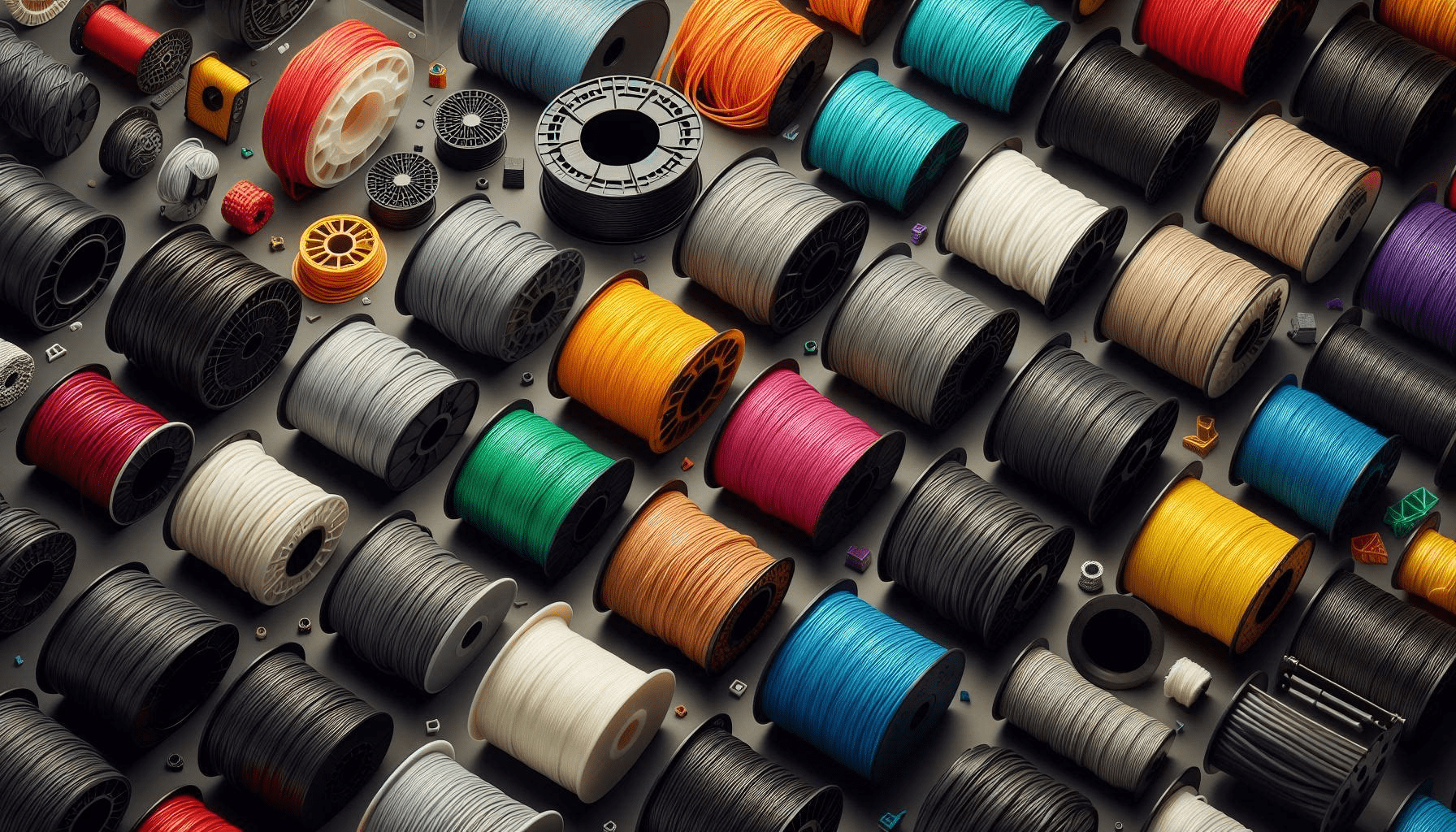
ABS Filament
Acrylonitrile Butadiene Styrene (ABS) is a common thermoplastic polymer typically used in FDM 3D printing. It’s known for its strength, flexibility, and high-temperature resistance, making it an ideal choice for applications that require durability and thermal stability.
Key Features of ABS Filament
ABS is tough and can withstand physical impacts and pressure. It maintains structural integrity at higher temperatures compared to other filaments like PLA.
While it’s strong, ABS still offers some flexibility, which prevents breaking under strain. Objects printed with ABS have a smooth, glossy finish, which can be sanded or chemically polished for an even more professional appearance.
Applications
ABS is suitable for printing custom parts that might be subjected to high temperatures or mechanical stress. It’s often used for items like phone cases, toys, and automotive body parts.
Printing with ABS
Printer Settings: ABS requires a heated bed and an enclosed print area to prevent warping.
Temperature: The extrusion temperature for ABS is typically between 210°C and 250°C.
Post-Processing: ABS can be finished with acetone vapor to create a smooth surface.
ASA Filament
Acrylonitrile Styrene Acrylate (ASA) is a 3D printing filament that is known for its exceptional weather resistance and UV stability, making it an excellent choice for outdoor applications. It shares many characteristics with ABS, but stands out for its ability to retain color and physical properties when exposed to the elements.
Key Features of ASA Filament
ASA won’t degrade or discolor when exposed to sunlight over time. It withstands harsh weather conditions, including rain and snow.
Similar to ABS, ASA is strong and can handle wear and tear. ASA provides a high-quality finish with less gloss than ABS, suitable for parts that will be visible in the final product.
Applications
ASA is ideal for signs and displays that need to endure outdoor conditions. It is also often used for car components that require durability and UV resistance.
Printing with ASA
Printer Settings: Like ABS, ASA requires a heated bed and benefits from an enclosed print area.
Temperature: The extrusion temperature for ASA is typically between 230°C and 260°C.
Post-Processing: ASA can be sanded and painted, though it requires less finishing than ABS due to its superior surface quality.
PLA Filament
Polylactic Acid (PLA) is one of the most popular 3D printing filaments used in FDM technology. It’s biodegradable and derived from renewable resources like cornstarch or sugarcane, making it an environmentally friendly option.
Key Features of PLA Filament
It has minimal warping, making it ideal for large prints and complex geometries. PLA is biodegradable and made from renewable resources.
It’s known for its ease of printing, adhering well to the print bed without the need for a heated bed or enclosure. PLA has a glossy finish and comes in a wide range of colors and translucencies.
Applications
PLA is great for conceptual models such as art, jewelry, and home decor due to its fine detail and aesthetic quality. It is also often used in schools due to its safety and ease of use.
Printing with PLA
Printer Settings: No heated bed is required, but it can benefit from a temperature of around 50°C.
Temperature: The extrusion temperature for PLA is typically between 180°C and 220°C.
Post-Processing: PLA can be sanded, glued, and painted, though it’s not as easy to smooth as ABS.
PET Filament
Polyethylene Terephthalate (PET) is a versatile and popular filament in 3D printing, known for its clarity and strength. It’s the same material used in plastic bottles and food containers, making it a familiar and recyclable option.
Key Features of PET Filament
PET is strong, impact-resistant, and doesn’t shatter easily. It can be transparent, which is great for applications requiring visibility.
With the proper certification, PET can be used for creating items that come into contact with food. It has very little odor and produces minimal warping, making it user-friendly.
Applications
PET is deal for mechanical parts due to its strength and durability. With the right certification, it can be used for kitchen gadgets or food storage.
Printing with PET
Printer Settings: A heated bed is recommended, typically around 70°C to 80°C.
Temperature: The extrusion temperature for PET is usually between 220°C and 250°C.
Post-Processing: PET can be sanded and is chemically resistant, allowing for various finishing techniques.
PETG Filament
Polyethylene Terephthalate Glycol (PETG) is a variant of the standard PET filament that has been modified with glycol to provide even better performance characteristics for 3D printing. It combines the ease of use of PLA with the strength and durability of ABS.
Mechanical Properties of PETG Filament
PETG is known for its toughness and resistance to impact. It offers more flexibility than PET, which reduces the risk of cracking under stress.
PETG has a higher temperature resistance than PLA, making it suitable for applications that require exposure to heat. It can be transparent, allowing for the creation of clear or translucent prints.
Applications
The strength and durability of PETG make it ideal for parts that need to withstand stress or strain. It is often used in the medical industry due to its chemical resistance and sterilizability.
Printing with PETG
Printer Settings: A heated bed is recommended, typically around 75°C to 90°C.
Temperature: The extrusion temperature for PETG is usually between 230°C and 250°C.
Post-Processing: PETG can be sanded and glued, and it’s less prone to warping, making it easier to work with than some other filaments.
PC Filament
Polycarbonate (PC) is a high-performance filament known for its excellent strength, toughness, and heat resistance. It’s a popular choice for engineering applications and for parts that require structural integrity under stress or heat.
Key Features of PC Filament
PC is incredibly strong, making it suitable for load-bearing applications. It can withstand temperatures up to 110°C, making it ideal for parts that will experience high heat.
PC can be transparent, offering clarity for projects that require see-through components. It has low shrinkage and warping, ensuring precise and stable prints.
Applications
PC is often used in engineering and industrial applications. It is suitable for components that must endure high temperatures and impact.
Printing with PC
Printer Settings: A heated bed is necessary, typically around 80°C to 120°C.
Temperature: The extrusion temperature for PC is usually between 260°C and 310°C.
Post-Processing: PC can be sanded, drilled, and painted, but it requires careful handling due to its strength.
PP Filament
Polypropylene (PP) is a plastic commonly used in a variety of applications due to its resistance to fatigue, flexibility, and semi-translucency. PP filament is popular in 3D printing for its lightweight properties and chemical resistance.
Key Features of PP Filament
PP is resistant to most acids and bases, making it suitable for containers and parts that will be exposed to chemicals. It’s highly resistant to fatigue, allowing for the creation of parts with living hinges.
PP offers a good balance of strength and flexibility, which can be advantageous for snap-fit parts. It is lighter than other plastics, which is beneficial for applications where weight is a concern.
Applications
PP is ideal for creating parts that require repeated flexing, such as bottle caps. Due to its fatigue resistance, it is also used for non-stress parts in the automotive industry.
Printing with PP
Printer Settings: PP can be challenging to print due to its low adhesion properties; a heated bed and adhesion promoters are recommended.
Temperature: The extrusion temperature for PP is typically between 220°C and 250°C.
Post-Processing: PP can be difficult to bond with adhesives, but it can be welded with a hot air gun or similar tool.
Nylon (PA) Filament
Nylon, also known as Polyamide (PA), is a synthetic thermoplastic linear polymeric material that is widely used in 3D printing for its strength and durability. It is particularly valued for its flexibility and resistance to abrasion, making it suitable for functional parts that require a degree of toughness.
Key Features of Nylon Filament
Nylon is exceptionally strong and resistant to impact and abrasion. It has a high degree of flexibility, which helps in creating parts that can bend without breaking.
Nylon can withstand higher temperatures, maintaining its properties under thermal stress. It absorbs moisture, which can affect dimensional stability but also makes it less brittle.
Applications
Due to its strength and durability, nylon is ideal for mechanical components. It is often used for protective gear and casings that require a tough exterior.
Printing with Nylon
Printer Settings: A heated bed is recommended, and some Nylons may require an enclosed print area to reduce warping.
Temperature: The extrusion temperature for Nylon is typically between 240°C and 260°C.
Post-Processing: Nylon can be dyed to different colors after printing and can be smoothed with various techniques.
Carbon Fiber Filament
Carbon Fiber Filament is a composite material that combines a standard thermoplastic base (such as PLA, PETG, or Nylon) with carbon fibers. This blend results in a filament that offers enhanced stiffness, strength, and dimensional stability, making it a top choice for high-performance applications.
Key Features of Carbon Fiber Filament
The addition of carbon fibers significantly increases the filament’s rigidity and strength. Despite its strength, carbon fiber filament is lightweight, which is advantageous for parts where weight is a critical factor.
It has minimal shrinkage and warping, ensuring precision in printed parts. Prints have a unique, textured surface that is visually appealing and can hide layer lines.
Applications
Carbon fiber is ideal for components that require a high strength-to-weight ratio. It is suitable for creating frames, supports, and other load-bearing parts.
Printing with Carbon Fiber Filament
Printer Settings: Requires a hardened steel nozzle to prevent wear from the abrasive fibers.
Temperature: The extrusion temperature varies depending on the base material but is typically higher than the standard filament.
Post-Processing: The filament can be sanded for a smoother finish, though its nature often reduces the need for post-processing.
CPE Filament
Co-polyester (CPE) filaments are a group of thermoplastic materials that offer a beneficial combination of properties from both PET and PLA. They are known for their high dimensional stability, impact resistance, and minimal warping, making them suitable for a wide range of applications.
Key Features of CPE Filament
CPE is resistant to chemicals, including oils, greases, and solvents. Exhibits minimal shrinkage and warping, which is crucial for precision parts.
Offers excellent toughness and abrasion resistance. Similar to PLA, CPE can be easier to print with than some other filaments.
Applications
CPE is ideal for prototyping parts that require precise dimensions and strength. It is suitable for creating durable goods that can withstand everyday use.
Printing with CPE
Printer Settings: A heated bed is recommended, typically around 70°C to 85°C.
Temperature: The extrusion temperature for CPE is usually between 240°C and 270°C.
Post-Processing: CPE can be sanded and finished with various techniques to achieve the desired aesthetic.
PVA Filament
Polyvinyl Alcohol (PVA) is a unique filament used primarily as a support material in 3D printing. Its defining feature is its water solubility, which allows for easy removal of support structures without damaging the primary print.
Key Features of PVA Filament
PVA dissolves in water, which means support structures can be removed by simply submerging the print in water. Safe for use in any environment, PVA is non-toxic and biodegradable.
Works well with a variety of materials, particularly PLA and some types of nylon, making it ideal for prints with intricate designs.
Applications
PVA is essential for models with overhangs or internal cavities that are impossible to print without support structures. While, it allows for the creation of prototypes with fine details, as the supports can be completely dissolved, leaving a clean finish.
Printing with PVA
Printer Settings: It does not require a heated bed, but if one is used, a temperature of 50°C to 60°C is recommended.
Temperature: The extrusion temperature for PVA typically ranges from 180°C to 220°C.
Post-Processing: After printing, the PVA supports can be removed by immersing the print in water for a few hours, depending on the size and complexity of the supports.
PEEK Filament
Polyether Ether Ketone (PEEK) is a high-performance engineering thermoplastic that offers exceptional mechanical, thermal, and chemical resistance properties. It is one of the most advanced filaments available for FDM 3D printing and is often used in demanding industrial applications.
Key Features of PEEK Filament
PEEK has excellent strength-to-weight ratio, stiffness, and dimensional stability. It can withstand continuous use at temperatures up to 250°C and is resistant to thermal degradation.
PEEK is impervious to a wide range of chemicals, including hydrocarbons and organic solvents. It is biocompatible, making it suitable for medical implant applications.
Applications
PEEK is ideal for components that require lightweight materials with high strength, thermal resistance, and excellent electrical properties. Due to its biocompatibility and sterilizability, it is also great for surgical instruments, implants, and devices.
Printing with PEEK
Printer Settings: Requires a high-temperature printer capable of reaching nozzle temperatures of 360°C to 400°C and a heated bed of 120°C to 160°C.
Post-Processing: PEEK can be machined, drilled, and welded, offering versatility in finishing techniques.
POM Filament
Polyoxymethylene (POM), also known as Acetal or by the brand name Delrin, is a highly crystalline thermoplastic with excellent mechanical properties. It's favored in precision parts that require high stiffness, low friction, and excellent dimensional stability.
Key Features of POM Filament
POM is very rigid, which makes it suitable for parts that must retain their shape under stress. It has a low coefficient of friction and is wear-resistant, ideal for gears and moving parts.
It exhibits minimal shrinkage and warping, ensuring accurate and consistent prints, and it is resistant to many solvents, fuels, and chemicals, making it useful for automotive parts and containers.
Applications
POM's low friction and wear resistance make it perfect for creating high-performance gears. It is suitable for prototyping parts that will be subject to mechanical stress or chemical exposure.
Printing with POM
Printer Settings: A heated bed is recommended, typically around 100°C to 130°C.
Temperature: The extrusion temperature for POM is usually between 210°C and 230°C.
Post-Processing: POM can be machined and polished to achieve a smooth surface finish.
PMMA (Acrylic) Filament
Polymethyl Methacrylate (PMMA), commonly known as acrylic, is a transparent thermoplastic often used as a lightweight, shatter-resistant alternative to glass. In 3D printing, PMMA filament is valued for its optical clarity and aesthetic qualities.
Key Features of PMMA Filament
PMMA can be as transparent as glass, making it ideal for applications requiring clear visibility. It can be colored or tinted, offering a range of visual options.
While not as tough as polycarbonate, PMMA is still more impact-resistant than glass. It resists yellowing and degradation under UV light, preserving its clarity over time.
Applications
Due to its light-transmitting properties, PMMA is used to create lamp covers and light diffusers. It is ideal for projects and decorative items that benefit from its glass-like and transparent appearance.
Printing with PMMA
Printer Settings: A heated bed is recommended, typically around 80°C to 100°C.
Temperature: The extrusion temperature for PMMA is usually between 230°C and 250°C.
Post-Processing: PMMA can be polished to enhance its transparency and can be glued using specific adhesives.
PVC Filament
Polyvinyl Chloride (PVC) is a common and versatile plastic used in a wide range of products. In 3D printing, PVC filament is appreciated for its durability, chemical resistance, and ease of use.
Key Features of PVC Filament
PVC is tough and has a high resistance to impact and wear. It can withstand exposure to a variety of chemicals, making it suitable for industrial applications.
PVC filament can be printed at lower temperatures than some other plastics, which can be beneficial for energy savings and printer longevity.
Applications
Due to its durability and chemical resistance, PVC is commonly used to create plumbing and electrical conduits. It is also used in a variety of consumer products, including toys, containers, and household tools.
Printing with PVC
Printer Settings: A heated bed is not strictly necessary but can be used at around 60°C to 70°C.
Temperature: The extrusion temperature for PVC is typically between 210°C and 230°C.
Post-Processing: PVC can be glued, painted, and sealed, offering a range of finishing options.
TPU Filament
Thermoplastic Polyurethane (TPU) is a type of filament known for its flexibility, durability, and resistance to oils and greases. It’s a popular choice for 3D printing applications that require the printed objects to be flexible or elastic.
Key Features of TPU Filament
TPU can be stretched and flexed while still maintaining its original shape. It’s resistant to abrasion and has a high level of toughness.
TPU stands up well against oils, greases, and many solvents. Available in different grades of hardness, TPU can be used to print everything from soft, rubbery items to firmer, more rigid objects.
Applications
TPU is ideal for phone cases, camera covers, wristbands, watch straps, and other protective gear. It is also perfect for creating watertight seals due to its flexibility and durability.
Printing with TPU
Printer Settings: A direct drive extruder is often recommended for TPU to reduce the chances of filament buckling.
Temperature: The extrusion temperature for TPU is typically between 220°C and 250°C.
Post-Processing: TPU objects generally require little to no post-processing due to their flexibility and finish.
TPE Filament
Thermoplastic Elastomers (TPE) are a class of filaments that combine the properties of rubber with the processing capabilities of thermoplastics. They are known for their flexibility, elasticity, and soft touch, making them ideal for a range of applications that require a “grippy” or soft surface.
Key Features TPE Filament
TPE can be stretched and flexed significantly while still returning to its original shape. Offers a rubber-like feel, which is comfortable to handle and provides excellent grip.
Resistant to impact, abrasion, and many environmental factors. Available in different shore hardnesses to suit various applications, from soft and flexible to firmer yet still bendable.
Applications
TPE is ideal for phone cases, wearable accessories, and other items that benefit from a soft, flexible touch. It is also used in children’s toys for its soft texture and safety due to its non-toxic nature.
Printing with TPE
Printer Settings: For better control, a direct-drive extruder may be required. A heated bed can be used at around 30°C to 50°C.
Temperature: The extrusion temperature for TPE is typically between 200°C and 230°C.
Post-Processing: TPE parts usually require little to no post-processing due to their finish and flexibility.
HIPS Filament
High-impact polystyrene (HIPS) is a filament known for its strength and ease of use. It's often used as both a standalone material and as support for more complex prints. Similar to ABS in its properties, HIPS is also dissolvable in limonene.
Key Features of HIPS Filament
HIPS is durable and can withstand sudden impacts, making it suitable for robust parts. It prints smoothly and adheres well to the print bed, reducing the likelihood of warping.
It can be dissolved in limonene, which makes it an excellent support material for complex prints. HIPS 3D printed can be glued, painted, and sanded, allowing for a high-quality finish.
Applications
HIPS is ideal for prototypes that require subsequent assembly or painting. It can also be used in dual-extrusion printers to support overhangs and complex geometries.
Printing with HIPS
Printer Settings: A heated bed is recommended, typically around 100°C to 115°C.
Temperature: The extrusion temperature for HIPS is usually between 230°C and 245°C.
Post-Processing: HIPS supports can be removed by soaking the print in limonene, leaving a clean and smooth surface.
Metal Filament
Metal Filament is a type of composite 3D printing material that blends fine metal powder with a base thermoplastic polymer. This unique combination allows for the creation of prints with metallic properties and finishes, which can be post-processed to achieve the look and feel of solid metal.
Key Features of Metal Filament
Provides the weight, feel, and aesthetic of metal in the finished print. Can be sanded, polished, and even electroplated to enhance the metallic appearance.
After printing, the objects can be worked with tools designed for metal materials. Available in a variety of metals, including stainless steel, bronze, copper, and more.
Applications
Metal filament is ideal for creating intricate designs in jewelry and art pieces that benefit from a metallic finish. It is suitable for parts that require the thermal or electrical properties of metal or need to mimic the properties of metal components.
Printing with Metal Filament
Printer Settings: This printer requires a heated bed and may need a nozzle capable of handling the filament's abrasive nature.
Temperature: The extrusion temperature for metal filament is typically higher than standard filaments, often between 200°C and 230°C.
Post-Processing: Parts printed with metal filament can be sintered in a kiln to burn out the plastic and fuse the metal particles, resulting in a 100% metal part.
Choose the Right Materials for Your Project
Selecting the appropriate material for your 3D printing project is crucial for its success. The choice will impact not only the printing process but also the functionality and longevity of the printed object.
By carefully considering the following factors, you can choose the most suitable material that will ensure the success of your 3D printing project.
Key Considerations for 3D Printer Filament Choice
● Mechanical Properties: Assess the strength, flexibility, and durability required for the object. Materials like Nylon and ABS offer high strength and durability, while TPU and TPE provide flexibility.
● Thermal Properties: If the object will be exposed to heat, consider materials with high-temperature resistance, such as PC or PEEK.
● Chemical Resistance: Due to their chemical inertness, materials like PP or PETG are excellent choices for objects that will come into contact with chemicals.
● Electrical Properties: If electrical insulation is necessary, materials like ABS or PEEK might be suitable.
● Biocompatibility: For medical applications, materials like PEEK or certain grades of PLA can be appropriate.
● Aesthetic Requirements: For objects where appearance is key, consider materials like PLA for a wide range of colors or metal filaments for a metallic finish.
● Environmental Factors: If the object is used outdoors, materials with UV resistance, such as ASA, or weather-resistant properties are essential.
● Regulatory Compliance: Ensure the material meets any specific industry regulations, especially for food contact, medical, or aerospace applications.
● Post-Processing: Some materials, like ABS, can be smoothed with acetone, while others, like metal filament, can be sanded and polished.
● Printer Compatibility: Verify that your printer can handle the material’s requirements, such as a heated bed for ABS or a high-temperature nozzle for PEEK.
● Cost and Availability: Consider the cost of the filament and its availability. Specialty materials like PEEK are more expensive and may not be as readily available as PLA or ABS.
Check out Our Special Offers
Featuring Process
- Coming Soon
Featuring Materials
- Coming Soon












